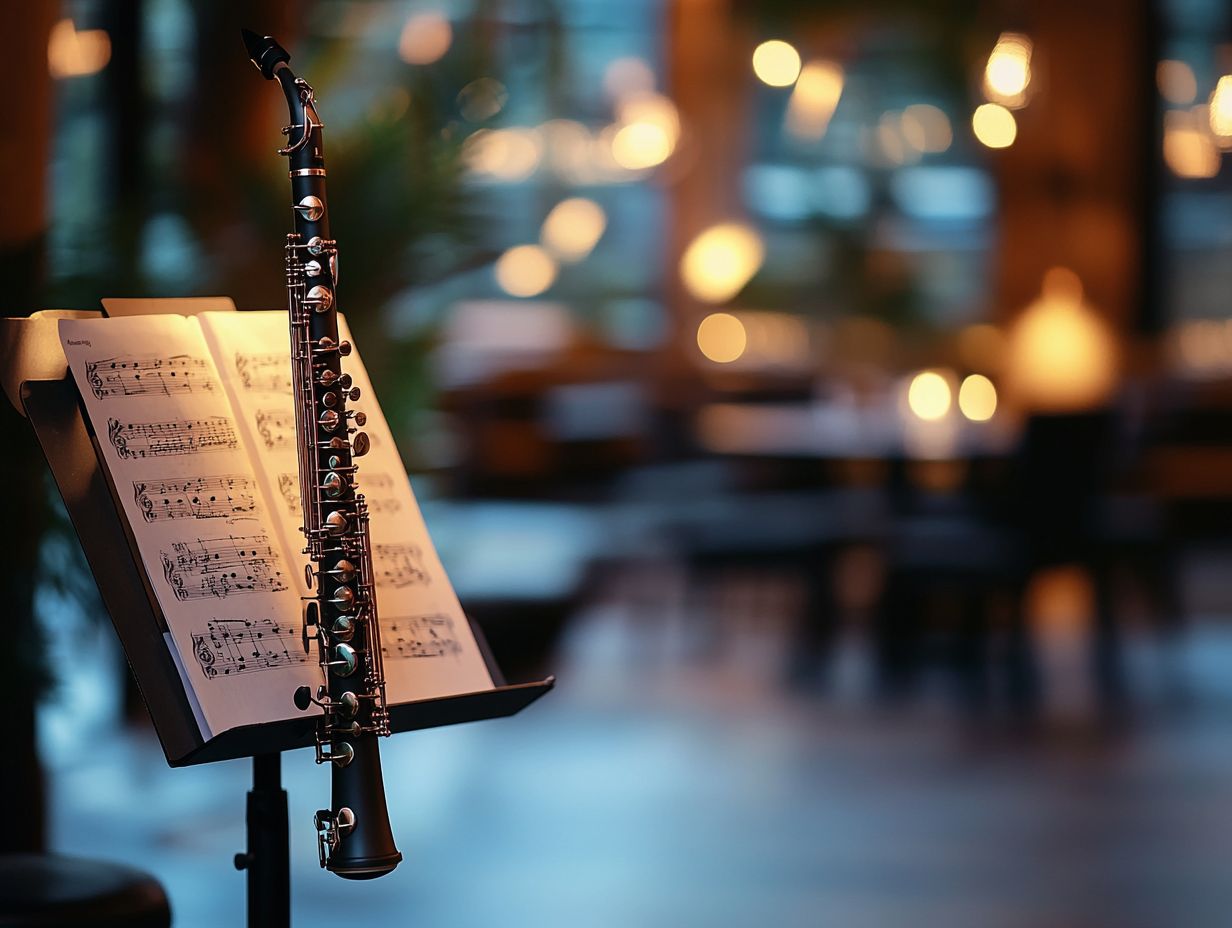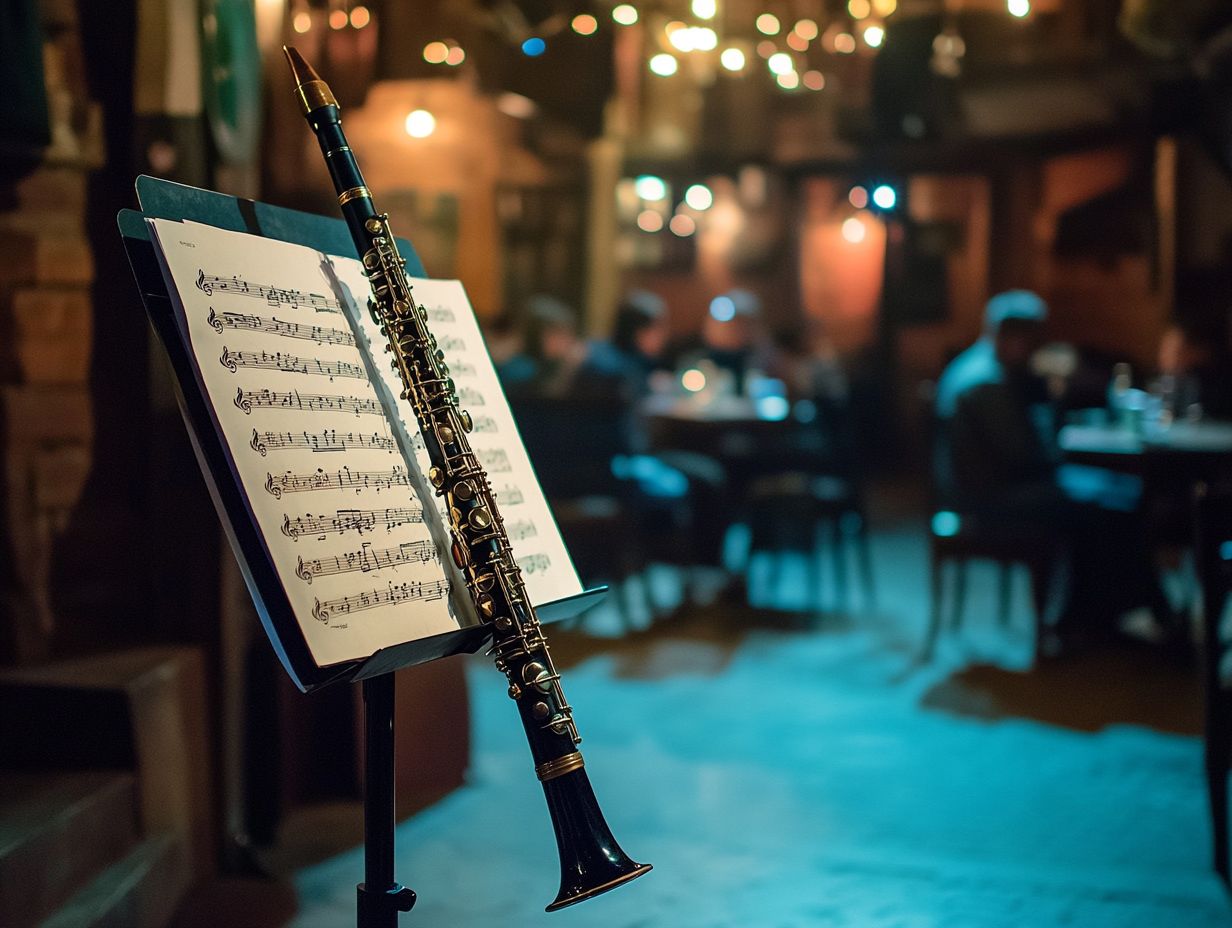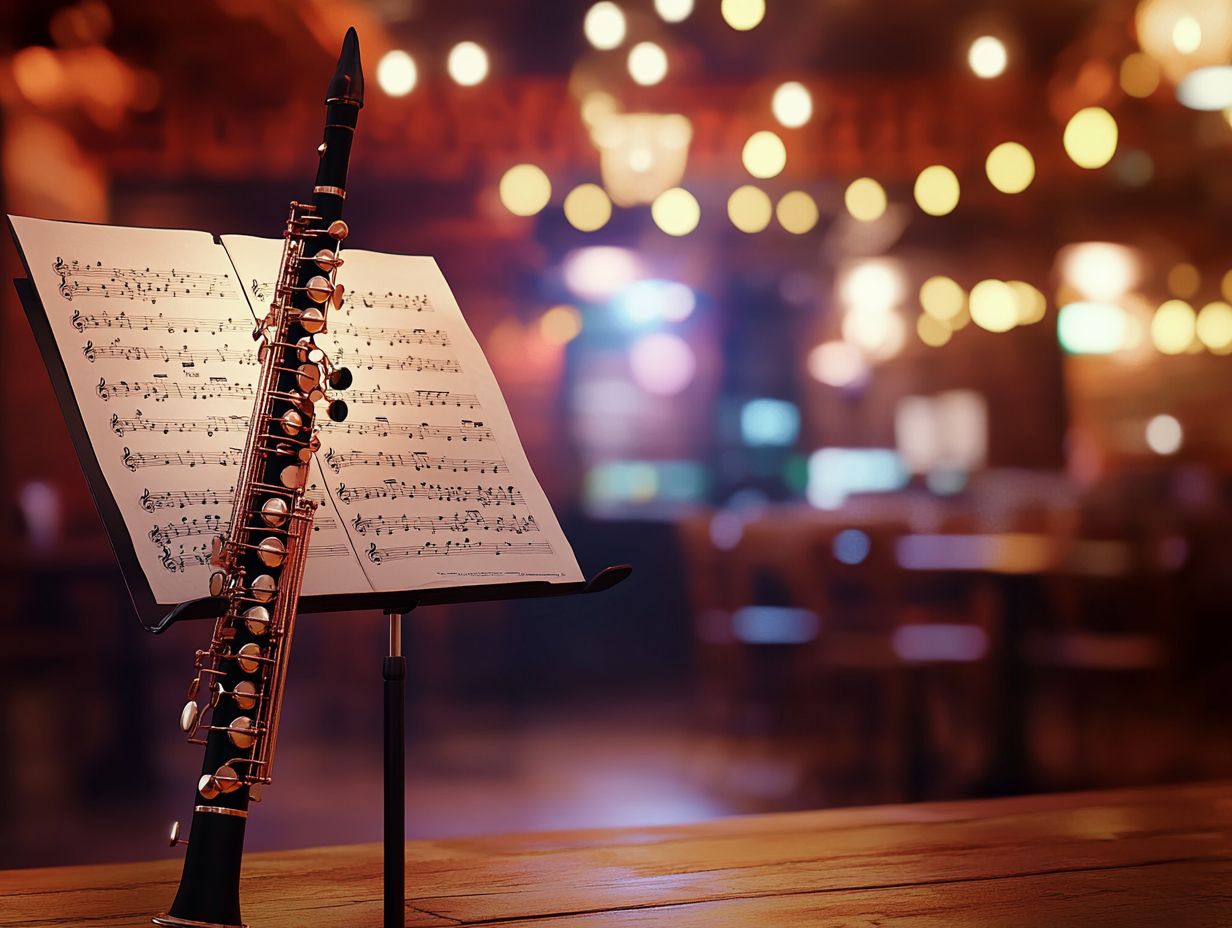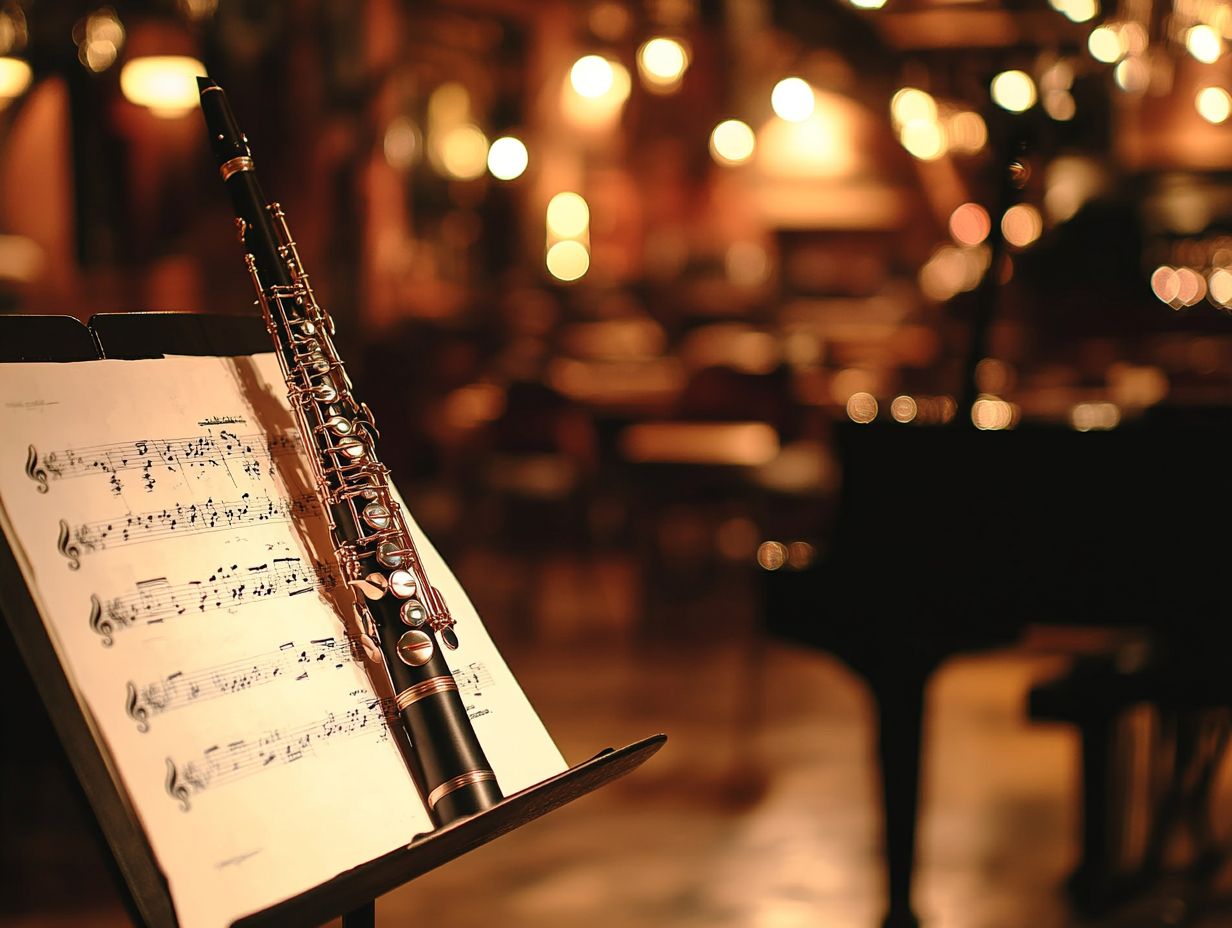The clarinet has transitioned from being a prominent instrument in classical orchestras to a key instrument in the jazz genre. This evolution highlights the dynamic nature of musical styles and showcases the clarinet’s remarkable adaptability.
This article explores the clarinet’s orchestral history, its significance within orchestras, and its rise as a major instrument in jazz. Additionally, it examines the pioneers who facilitated this transition and offers guidance for clarinetists seeking to navigate this shift successfully.
Contents
The Evolution of the Clarinet

The evolution of the clarinet is a fascinating journey that illustrates its transformation from a classical instrument to a key component in jazz, highlighting its significance within both genres.
The clarinet’s history encompasses a diverse range of styles, techniques, and cultural influences that reflect the artistry and virtuosity of the musicians who have embraced it.
In this article, we will explore the evolution of the clarinet, focusing on the instrument itself, its role in the orchestra, and its integration into various musical traditions.
From Classical to Jazz
The clarinet transitioned from classical music to jazz as it developed its own voice and style as a solo instrument within a genre defined by improvisation and rhythm. This shift was significantly influenced by musicians such as Benny Goodman, known as the ‘King of Swing,’ and Artie Shaw, who played crucial roles in popularizing the clarinet in jazz ensembles.
The clarinet’s warm, rich sound facilitates wide expressive improvisation, and jazz musicians have continuously pushed the boundaries of this instrument to explore new sonic possibilities. With the rise of jazz in the early 20th century, clarinetists began to incorporate blues elements and syncopated rhythms into their playing, allowing the clarinet to blend seamlessly with other jazz instruments, particularly the trumpet and piano.
The evolution of the clarinet from the classical tradition to a primary jazz instrument exemplifies its versatility, as it has successfully crossed various styles while establishing a unique voice in both genres.
The Role of the Clarinet in Orchestras
The clarinet plays a crucial role in the orchestra by contributing to the overall sound and dynamics. It serves as a bridge between the woodwinds and other sections, enriching the orchestral performance with its unique timbre and expressive capabilities.
History and Importance

The history of the clarinet in orchestras is characterized by its growing significance as a key woodwind instrument, evolving in design and capabilities to meet the demands of composers and conductors throughout musical history.
Over the centuries, the clarinet has undergone remarkable transformations, with innovations in its construction leading to the development of the modern clarinet we recognize today. These advancements include the introduction of the Boehm system, which enhanced the instrument’s technical capabilities and expanded its range.
Composers such as Mozart, Brahms, and Debussy embraced the clarinet, enriching orchestral compositions with its unique timbre and expressive qualities. The clarinet’s versatility has allowed it to blend seamlessly with other instruments, making it a favorite across various musical genres.
This evolution not only reflects changes in musical culture but also underscores the clarinet’s enduring legacy within the orchestral framework.
The Rise of the Clarinet in Jazz
The rise of the clarinet in jazz represents a significant chapter in the history of the genre. It gained prominence among jazz musicians due to its expressive sound, improvisational capabilities, and ability to convey intense emotions through rhythmic and melodic expression in live performances.
From New Orleans to Swing
The clarinet has played a crucial role in the jazz genre since its inception in New Orleans and through its evolution during the swing era, helping to shape the sound and musical expression of this vibrant style as it spread across clubs and performances.
The development of jazz music in the streets of New Orleans quickly established the clarinet as a hallmark instrument, reflecting the improvisational essence of traditional jazz. The expressive performances of early artists like Sidney Bechet and Johnny Dodds highlighted the clarinet’s ability to serve as both a singing and shouting voice, capturing the diverse aspects of life in this lively city.
As jazz transitioned to the swing era, renowned artists such as Benny Goodman contributed to the clarinet’s popularity. The instrument continued to captivate audiences in the smoke-filled rooms of jazz clubs, becoming a staple of the genre that spread throughout the country.
Famous Jazz Clarinetists

Renowned jazz clarinetists have played a pivotal role in shaping the sound of jazz as both pioneers and innovators. Their artistry and improvisational skills have made a lasting impact on the genre and have influenced generations of musicians.
Pioneers and Innovators
Pioneers and innovators in jazz clarinet have significantly advanced the technical aspects of the instrument while infusing their performances with creativity and expression, thereby setting new standards for musicality in jazz.
These artists have carved out unique sonic spaces, often drawing inspiration from a wide range of influences, including classical music and blues, which enriches the genre. Their contributions go beyond mere technical skill; they have redefined the role of the clarinet in jazz ensembles, using it as a medium for emotional storytelling.
Notable clarinetists such as Sidney Bechet and Benny Goodman have exemplified this artistry by incorporating innovative improvisational techniques that resonate with audiences and inspire future musicians. This relentless pursuit of personal and artistic expression not only highlights the versatility of the clarinet but also underscores the transformative power of jazz as a reflection of cultural dynamics.
The Clarinet in Modern Jazz
The clarinet in modern jazz is defined by a diverse range of styles and techniques, highlighting the instrument’s adaptability and the innovative spirit of contemporary musicians who continue to push the boundaries of jazz performance.
Contemporary Styles and Techniques

Contemporary styles and techniques for the clarinet in jazz encompass a harmonious blend of traditional approaches and innovative methods, enabling musicians to explore new soundscapes and expressions while honoring the instrument’s rich heritage.
This fusion has resulted in the creation of unique musical dialogues, where improvisation takes center stage and expands the boundaries of what the clarinet can achieve.
Clarinetists frequently experiment with extended techniques such as multiphonics, circular breathing, and altered fingerings, enriching their performances with complex textures and timbres.
As they explore modern jazz idioms, performers also draw inspiration from genres like funk and world music, incorporating rhythmic variations and melodic nuances that reflect their personal stories.
This dynamic approach not only showcases their technical prowess but also enhances their ability to convey deep emotional experiences, resulting in captivating performances that resonate with diverse audiences.
Transitioning from Orchestras to Jazz Clubs
The transition from orchestras to jazz clubs can be challenging for clarinetists. This difficulty arises from the differing performance environments and audience dynamics, as well as the need to adapt to the improvisational nature of jazz music.
Challenges and Opportunities
Clarinetists transitioning to jazz face challenges in their performance styles, but they also encounter valuable opportunities for artistic expression and collaboration within the jazz community.
The challenges can be significant; for instance, they must learn to create melodies spontaneously while navigating complex chord changes and syncopated rhythms that are characteristic of jazz music. Successful clarinetists like Anat Cohen have demonstrated how to innovate and push the boundaries of the genre while still honoring its roots.
This transition opens up a wide range of collaborative opportunities, such as participating in ensembles where improvisation takes center stage, allowing them to engage musically with fellow artists in real-time. Additionally, workshops and jam sessions offer clarinetists mentorship from established jazz musicians, further enriching their creative journey and enhancing their performance skills.
Tips for Clarinetists Making the Switch
The best tips for clarinetists transitioning from classical to jazz music include adapting to new techniques and developing improvisation skills to fully engage with the genre.
Adapting to a New Genre
Adapting to a new genre like jazz requires clarinetists to explore various improvisational techniques and develop a deeper understanding of jazz theory and its distinctive rhythms. This journey begins with a commitment to learning the essential elements of jazz, including swing rhythms, syncopation, and common chord progressions.
Musicians often find it beneficial to study the works of renowned jazz artists, as immersing themselves in this repertoire provides invaluable insights into style and phrasing. Technical adjustments are also crucial; clarinetists must practice exercises that emphasize breath control, articulation, and dynamics to achieve the signature jazz sound.
Regular practice sessions, combined with improvisation drills, foster versatility and confidence, ultimately enhancing their overall musicianship as they navigate the vibrant landscape of jazz music.
